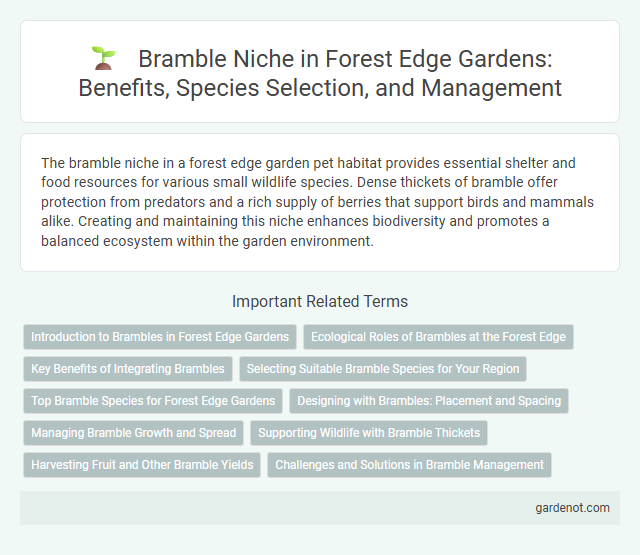The bramble niche in a forest edge garden pet habitat provides essential shelter and food resources for various small wildlife species. Dense thickets of bramble offer protection from predators and a rich supply of berries that support birds and mammals alike. Creating and maintaining this niche enhances biodiversity and promotes a balanced ecosystem within the garden environment.
Introduction to Brambles in Forest Edge Gardens
Bramble plants thrive in forest edge gardens by naturally adapting to the transitional zone between woodland and open space. They provide essential habitat and food for wildlife, supporting biodiversity and soil health. Cultivating brambles in these niches enhances ecological balance and offers sustainable fruit production.
Ecological Roles of Brambles at the Forest Edge
Brambles at the forest edge create a vital ecological niche by providing dense habitat and shelter for various wildlife species, including birds, insects, and small mammals. Their thorny thickets protect nests from predators while offering abundant berries that serve as a crucial food source during late summer and autumn. These plants also contribute to soil stabilization and nutrient cycling, enhancing the forest edge's overall biodiversity and ecosystem resilience.
Key Benefits of Integrating Brambles
Integrating brambles into a forest edge garden enhances biodiversity by providing essential habitat and food sources for pollinators and wildlife. Their dense thorny growth offers natural protection against erosion and creates microclimates that support understory plants. Brambles also contribute to soil health through leaf litter decomposition, enriching nutrient cycles and promoting sustainable garden ecosystems.
Selecting Suitable Bramble Species for Your Region
Selecting suitable bramble species for your forest edge garden involves considering local climate, soil type, and native biodiversity. Opt for species like Rubus fruticosus in temperate zones or Rubus ursinus in milder coastal regions to ensure optimal growth and natural pest resistance. Integrating region-appropriate brambles enhances ecosystem balance and promotes a sustainable garden environment.
Top Bramble Species for Forest Edge Gardens
Top bramble species for forest edge gardens include Rubus fruticosus (common blackberry), Rubus allegheniensis (Allegheny blackberry), and Rubus ursinus (trailing blackberry), all valued for their high fruit yield and adaptability to partial shade conditions. These species thrive in the rich, well-drained soils typical of forest edges, providing dense, thorny habitat that supports pollinators and wildlife. Their vigorous growth habit and resilience make them ideal for naturalistic garden settings seeking a balance of productivity and biodiversity.
Designing with Brambles: Placement and Spacing
Designing with brambles requires careful placement and spacing to ensure healthy growth and maximize fruit production. Plant brambles at least 3 to 4 feet apart in rows spaced 6 to 8 feet apart to provide adequate airflow and sunlight penetration. This strategic arrangement reduces disease risk and facilitates easier maintenance and harvesting in forest edge gardens.
Managing Bramble Growth and Spread
Effective management of bramble growth and spread in a forest edge garden involves regular pruning to prevent overgrowth and maintain plant health. Mulching around the base helps suppress unwanted seedlings, while periodic removal of suckers reduces invasive tendencies. Implementing these techniques preserves biodiversity and supports the balance of native flora.
Supporting Wildlife with Bramble Thickets
Bramble thickets provide essential habitat and shelter for various wildlife species, including birds, insects, and small mammals, making them a vital component of forest edge gardens. Their dense structure offers nesting sites and protection from predators, while the abundant flowers and berries serve as a crucial food source throughout the seasons. Incorporating bramble niches promotes biodiversity by supporting pollinators and enhancing the natural ecosystem balance in garden environments.
Harvesting Fruit and Other Bramble Yields
Bramble plants produce a bountiful harvest of blackberries and raspberries, rich in vitamins and antioxidants. Regular picking during peak ripeness ensures maximum fruit quality and encourages continued growth throughout the season. Beyond fruit, bramble leaves and young shoots can be used for teas and natural remedies, enhancing the garden's sustainable yield.
Challenges and Solutions in Bramble Management
Managing brambles in a forest edge garden presents challenges such as rapid growth, dense thicket formation, and competition with native plants for nutrients and sunlight. Effective solutions include regular pruning to control spread, mulching to suppress unwanted seedlings, and selective herbicide application to minimize environmental impact. Integrating native ground covers can also reduce bramble dominance while promoting biodiversity.
Bramble niche Infographic

 gardenot.com
gardenot.com